Bangladesh Railway
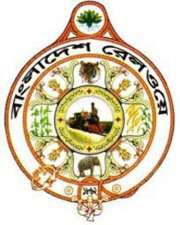 | |
| Department of the Government of Bangladesh | |
| Industry | Railways and locomotives |
| Founded | 1862 |
| Headquarters | Dhaka, Bangladesh |
Area served | Bangladesh |
Key people | Mohammad Amzad Hossain, Director General of Bangladesh Railway[1] |
| Revenue | ৳ 8,002 million[2] (2014) |
|
| |
Number of employees | 27,535[3] (2015) |
| Parent | Government of Bangladesh |
| Divisions | East Zone and West Zone |
| Website |
www |
| Bangladesh Railway | |
|---|---|
| Operation | |
| National railway | Railway ministry |
| Major operators | Bangladesh railway |
| Statistics | |
| Ridership | 65 million (2014) [2] |
| Passenger km | 8,135 million[2] |
| Freight | 2.52 million tonnes[2] |
| System length | |
| Total | 2,885 km[2] |
| Double track | 364 km[2] |
| Track gauge | |
| Metre gauge | 1,838 km[2] |
| Broad gauge | 682 km[2] |
| Features | |
| No. bridges |
3,650[2] Major= 546 Minor=3,104 |
| Longest bridge |
Bangabandhu Bridge (dual gauge, 4.8 km) Hardinge Bridge (broad gauge, 1.8 km) |
| No. stations | 498 |

Bangladesh Railway (Bengali: বাংলাদেশ রেলওয়ে) is the state owned rail transport agency of Bangladesh. It operates and maintains all railways in the country, and is overseen by the Directorate General of Bangladesh Railway. The Bangladesh Railway is governed by the Ministry of Railways and the Bangladesh Railway Authority. Its reporting mark is "BR".[4]
The Bangladesh Railway system has a total length of 2,855 route km. In 2009, Bangladesh Railway had 34,168 employees.[5] In 2014, Bangladesh Railway carried 65 million passengers and 2.52 million tonnes of freight. The railway made 8,135 million passenger-kilometres and 677 million tonne-kilometres.[2]
History
Rail transport in Bangladesh began on 15 November 1862, when 53.11 km of 5 ft 6 in (1,676 mm) (broad gauge) line was opened between Darshana in Chuadanga District and Jogotee in Kushtia District. On 4 January 1885, a further 14.98 km 1,000 mm (3 ft 3 3⁄8 in) (metre gauge) line was opened. In 1891, the Bengal Assam Railway was constructed with the assistance of the government. It was later run by the Bengal Assam Railway Company.
On 1 July 1895, two sections of metre gauge railway were constructed by English railway companies. One connected Chittagong and Comilla (149.89 km). The other connected Laksam Upazila and Chandpur (50.89 km).[6]
In 1947, at the time of the Partition of India, the Bengal Assam Railway was divided into two parts. The 2,603.92 km of track located in East Pakistan, came under the control of the central Government of Pakistan. On 1 February 1961, the Eastern Bengal Railway was renamed the "Pakistan Eastern Railway". In 1962, control of the Pakistan Eastern Railway was transferred to the Government of East Pakistan. On 9 June 1962, by order of the president, the Pakistan Eastern Railway management was assumed by a Railway Board.[6]
In 2005, the total length of the Bangladesh Railway was 2,855 km.[7] There was 660 km of broad gauge track (mostly in the western region), 1,830 km of metre gauge track (mostly in the central and eastern regions) and 365 km of dual gauge track.[8] In 1998, the Jamuna Bridge was built to connect the previously divided east and west rail networks in dual gauge.[9]
In 2010, funding was received for a bridge over the Titas River.[10] In September 2010, the Government of Bangladesh approved ten rail development projects costing 19·9 billion Bangladeshi taka including plans for new tracks and rolling stock.[11]
In 2011, Sheikh Hasina Wazed, the Prime Minister of Bangledesh, officiated at the start of construction of a link which would cross several rivers to reach Cox's Bazar. The 100 km of gauge line started from the railhead at Dohazari, southeast of Chittagong. The plan was to reach Satkania, Dulahazra, Chakarin, Edgaon, Ramu and Cox's Bazar, with four major river bridges and a 28 km branch from Ramu to Gundum. In 2013, the Chittagong Circular Railway was completed.
In 2015, construction of a 15 km branch to Agartala, Tripura in Northeast India commenced.[12] In 2017, land acquisition took place to facilitate the construction.[13]
Structure
From the end of the Bangladesh Liberation War in 1971 until 1982, the railway was governed by a Railway Board. It then came under the Railway Division of the Ministry of Communications. The Director General of the railway was the Secretary of the Railway Division of the Ministry of Communications. In 1995, governance of the railway was assumed by the "Bangladesh Railway Authority" which was chaired by the Minister of Railways.[14] Inspections are made by an external government authority.
The features of Bangladesh Railway include the usage of several gauges and the division of the rail system by the Jamuna River, Brahmaputra into the Western Zone and the Eastern Zone of operations. Crossing the river is one bridge, the Jamuna Bridge which was completed in 2003.
The East Zone and the West Zone each have a General Manager who answers to the Director General of the Railway Authority. Each zone has its own raft of departments for operation, maintenance, and finances. Each zone is divided into two divisions with departments for personnel, transportation, commercial, finance mechanical, way and works signalling, telecommunication, electrical and medical services.
The East Zone has a workshop division in Pahartali. The West Zone's workshop division is in Saidpur. The railway has a central locomotive workshop for broad and metre gauge locomotives in Parbatipur. It also has a Railway Training Academy.[14] There is are diesel workshops in Pahartali, Dhaka and Parbatipur. Maintenance on coaches and wagons is carried out at the "C and W" shop in Saidpur, Nilphamari and at the "C and W" shop Pahartali.
Rolling stock
Locomotives
Diesel
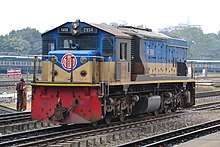
Bangladesh Railway's fleet of diesel locomotives includes both diesel-electric and diesel-hydraulic machines.[15] In 2007, there were 77 broad gauge diesel-electric locomotives. In 2012, Bangladesh Railway ordered 16 new broad gauge locomotives of 3100 hp from Diesel Locomotive Works, India.[16] There were also 208 metre gauge diesel-electric locomotives including those of Class 2000, Class 2600, Class 2700, and Class 2900. The total number was 285.
Steam
A small number of steam locomotives are preserved in Bangladesh.[17]
| Location | Builder | Wheel arrangement |
Gauge |
|---|---|---|---|
| Dhaka Railway HQ | Nippon | 2-8-2 | Metre gauge |
| Saidpur Works | W. G. Bagnall | 2-4-0T | 2 ft 6 in (762 mm) |
| Saidpur Works | Vulcan Foundry | 0-6-0 | 5 ft 6 in (1,676 mm) |
| Paksey Railway HQ | Vulcan Foundry? | 2-4-0T | 2 ft 6 in (762 mm) |
The 762 mm gauge locomotives are from the Rupsa – Bagerhat railway which was the only 762 mm gauge line in East Pakistan in 1947. It was changed to 1,676 mm gauge in 1970.
Freight and cargo services
As a national carrier, Bangladesh Railway is obliged to carry essential commodities such as grain and fertiliser to remote parts of Bangladesh at discounted rates. Bangladesh Railway transports containers from the Port of Chittagong to Dhaka Inland Container Depot, where there are customs facilities.[18] The rolling stock to carry containers was manufactured from existing stock. On 5 August 1991, a container-only train came into service. A goods train operates from Singhabad and Petrapole, India to Rohanpur and Benapole, Bangladesh.[19]
Accidents
- On July 10, 2014, a major freight train accident occurred near Faujdarhat Railway Station at 6.30 am. A freight train from Patenga was carrying furnace oil to a power plant, but near Faujdarhat the train derailed and leaked around 21,255 imp gal (96,630 l; 25,526 US gal) of furnace oil. Six wagons of the train derailed and oil from three of the wagons flowed into a nearby canal.[20]
- On September 14, 2016, a freight train derailed in the Faujdarhat area. The loco driver and the assistant driver were injured.[21]
Passenger services

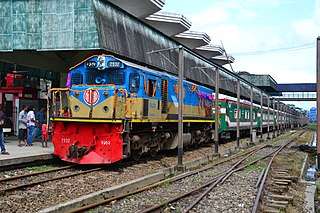
Rail is a principal mode of transport in Bangladesh. In the 2005 financial year, 42 million passengers travelled on the Bangladesh Railway.[22] Inter-city services, contribute to over seventy percent of Bangladesh Railway's revenue.[22] In 2014, the railway owned 312 broad gauge coaches and 1,164 metre gauge coaches.[2]
In 2017, Bangladesh Railway operated 90 inter-city trains (up & down), 52 mail or express trains, 64 commuter trains (DEMU), 135 shuttle or local trains and 2 international services.[23]
Two times per week, a passenger train operates a service to India. In April 2008, the Maitri Express between Dhaka and Kolkata came into operation on the Gede – Darsana route.[24] On 9 November 2017, a new weekly train, the Bandhan Express, came into operation between Khulna and Kolkata via Petrapole and Benapole (172 km).[25]
Tickets for Bangladesh Railway services are available at all stations. Most stations are computerised and tickets which can be purchased within four days of departure, are printed. Full refunds (excluding clerical charges) are available up until two days before departure. The railway reserves ten percent of tickets for online sales. Of these tickets, fifteen percent are reserved for mobile phone sales.[26]
Accidents
- On 11 July 2006, a train collided with a crowded bus at an unmanned railroad crossing at Akkelpur Upazila, Jaipurhat District. Thirty-three people died and thirty were injured.
- On 13 October 2007, the rear carriages of the Probhati Express derailed near Dhaka. Four people died and fifty were injured.
- On 16 April 2008, a Dinajpur – Dhaka Ekota express train collided with a local bus on a level crossing on the outskirts of Kalihati, Tangail District. Eighteen people died and thirty were injured.
- On 14 May 2008, an Upaban express train crashed into the rear of a Noakhali express train at the Ashuganj Upazila station, Brahmanbaria District. Eight people died and one hundred were injured.
- On 8 December 2010, a collision between two passenger trains killed at least ten people.[27]
Accommodation classes
Bangladesh Railway has three main passenger classes, "Air conditioned", "First" and "Second". Most trains do not provide the "Air conditioned" class. On inter-city and long-distance trains, a restaurant car and a power car are included at the centre of the train. All inter-city trains are partially air-conditioned, feature padded leather seats and provide passengers with on-demand sheets, pillows, blankets, as well as meals in a dining car. Some diesel–electric trains provider commuter services.[28]
| Class | Description |
|---|---|
| Tapanukul (তাপানুকূল) First class AC |
This is the most expensive class. This air-conditioned coach is used only on popular Inter-City routes. The coaches are carpeted, have sleeping accommodation, ample leg room and have privacy features like personal coupes. |
| First class (প্রথম শ্রেণী) | This class is relatively luxurious, but not air-conditioned; has sleeping berths, and ample leg room. |
| First class Chair (প্রথম শ্রেণী চেয়ার) |
Chair car or day coach with a total of five seats in a row on broad gauge trains and four seats in a row on metre gauge trains, used for daily travel. |
| 2nd Class-Shovon Chair (২য় শ্রেণী-শোভন চেয়ার) |
The 2nd Class Shovon Chair is basically a chair car preferred by most middle-class passengers. Has a total of five seats in a row on broad gauge trains and four seats in a row on metre gauge trains. |
| 2nd Class-Shovon (২য় শ্রেণী-শোভন) |
One of the cheapest classes; seats are not very comfortable. |
| 2nd Class-Shulov (২য় শ্রেণী- সুলভ) |
The cheapest accommodation, with seats made of pressed wood or steel and are cushioned. Only found in sub-urban and short-distance routes. Although entry into the compartment is guaranteed, a seat is not guaranteed. These coaches are usually very crowded. |
List of railway stations in Bangladesh
Kamalapur Railway Station is the central railway station in Dhaka. In 2015, Bangladesh Railway serviced 489 railway stations. These include one block hut, thirteen train halts and four goods booking points.
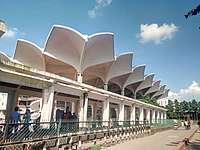
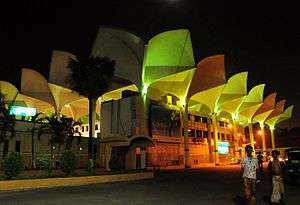

- Imambari Railway station,kasba,Chittagong
- Jessore railway station, broad gauge junction
- Santahar railway station, Bogra District, dual gauge junction
- Abdulpur railway station, Natore District, dual gauge junction
- Poradoho Jn, Kushtia, broad gauge junction
- Ahsanganj railway station Naogaon District
- Darshana Halt, broad gauge
- Chuadanga railway station
- Bheramara railway station, Kushtia, broad gauge
- Tangail railway station E, dual gauge
- Iswardi railway station W, broad gauge junction for Sirajganj and Jamuna.
- Ishwardi bypass W, dual gauge
- Birampur railway station
- Lalmonirhat railway station
- Burimari railway station
- Pabna railway station
- Rangpur railway station
- Kaunia railway junction
- Dinajpur railway station
- Chilahati railway station
- Rajshahi railway station
- Panchbibi railway station
- Joypurhat railway station
- Jamalganj railway station
- Jafarpur railway station
- Akkelpur railway Station
- Rohanpur railway station
- Sirajganj, W, river port terminus of branch from Iswardi, bypassed by Jamuna Bridge in 2003[29]
- Hili railway station, W, broad gauge
- Joydebpur railway station, E, dual gauge junction
- Syedpur, dual gauge
- Sylhet railway station, metre gauge
- Bhairab Bazar, metre gauge
- Khulna railway station, broad gauge
- Parbatipur railway station, junction with break of gauge
- Jamtoeel, E, dual gauge
- Ullapara railway station
- Chatmohor railway station
- Faridpur, SW
- Khulna railway station, SW, dual gauge
- Tongi railway junction, E, dual gauge junction just north of Dhaka
- Dhaka, E, dual gauge since 2007
- Kamalapur railway station, E, the main rail station in Dhaka
- Dhaka Cantonment rail station, E
- Airport railway station, Dhaka, E dual gauge
- Dewangonj
- Mymensingh Junction
- Mohonganj
- Chittagong, E, metre gauge
- Bongobondhu Shetu Purbo (East), E, dual gauge
- Gouripur, Bangladesh, E, meter gauge, junction
- Laksam Railway Junction E, metre gauge, junction
- Akhaura railway junction
- Kulaura railway station, metre gauge, junction
- Feni, metre gauge, junction
- Belunia, metre gauge, railway terminus and land port
See also

- Transport in Bangladesh
- Bandhan Express
- Parabat Express
- Kalni Express
- Lalmoni Express
- Dhaka–Chittagong high-speed railway
References
- ↑ "| Bangladesh Railway-Government of the People of Republic Bangladesh | বাংলাদেশ রেলওয়ে-গণপ্রজাতন্ত্রী বাংলাদেশ সরকার". Railway.portal.gov.bd. Retrieved 2016-08-06.
- 1 2 3 4 5 6 7 8 9 10 11 12 "Railway Reform Progress Report" (PDF). Adb.org. Retrieved 2016-08-07.
- ↑ Archived 2 June 2016 at the Wayback Machine.
- ↑ "রেলপথ মন্ত্রণালয়ের সংক্ষিপ্ত ইতিহাস ও প্রধান কার্যাবলী |Ministry of Railways-Government of the People's Republic of Bangladesh | রেলপথ মন্ত্রণালয়-গণপ্রজাতন্ত্রী বাংলাদেশ সরকার". www.mor.gov.bd. Retrieved 2017-08-17.
- ↑ "Archived copy". Archived from the original on 3 December 2009. Retrieved 2009-12-15.
- 1 2 "Archived copy". Archived from the original on 15 November 2007. Retrieved 2012-02-10.
- ↑ "Archived copy". Archived from the original on 20 December 2005. Retrieved 2005-12-26.
- ↑ "Archived copy". Archived from the original on 31 December 2009. Retrieved 2009-12-16.
- ↑ "Railway Route Map -Bangladesh Railway-Government of the People of Republic Bangladesh - বাংলাদেশ রেলওয়ে-গণপ্রজাতন্ত্রী বাংলাদেশ সরকার". Retrieved 6 August 2016.
- ↑ "Bangladesh and India Finalise Rail Projects". Railway Technology. Retrieved 20 March 2016.
- ↑ "Railway Gazette: Development projects get the go-ahead". Archived from the original on 29 September 2010. Retrieved 28 September 2010.
- ↑ "Work on new India-Bangladesh railway link from 2015". Times of India. Jun 17, 2014. Retrieved 7 December 2014.
- ↑ "Rail project to connect India and Bangladesh begins; land acquisition notices served to 257 families". Firstpost. 2017-07-30. Retrieved 2017-08-17.
- 1 2 "Ministry of Railways-Government of the People's Republic of Bangladesh | রেলপথ মন্ত্রণালয়-গণপ্রজাতন্ত্রী বাংলাদেশ সরকার". Mor.gov.bd. 2016-02-28. Retrieved 2016-08-07.
- ↑ "Archived copy". Archived from the original on 30 August 2011. Retrieved 2011-09-11.
- ↑ https://www.globalrailnews.com/2012/08/28/dlw-bags-order-for-16-locomotives-from-bangladesh-railways/
- ↑ "Preserved Steam Locomotives in Bangladesh". Internationalsteam.co.uk. Retrieved 2016-08-06.
- ↑ "Facilities of CPA – Chittagong Port Authority". cpa.gov.bd. Retrieved 20 March 2016.
- ↑ "India approves new railway link with Bangladesh". twocircles.net. Retrieved 20 March 2016.
- ↑ "Oil-laden train derails in Ctg". the daily star.
- ↑ "Home Bangladesh 2 injured in Ctg rail engine derailment". prothom alo.
- 1 2 "Archived copy". Archived from the original on 7 December 2009. Retrieved 2009-12-15.
- ↑ বাংলাদেশ রেলওয়ের যাত্রীবাহী ট্রেন. railway.portal.gov.bd (in Bengali). Retrieved 20 March 2016.
- ↑ "Bangladesh – India border reopens". Railway Gazette International. 5 August 2007.
- ↑ "Archived copy". Archived from the original on 18 May 2011. Retrieved 2008-09-02.
- ↑ "How to Buy Bangladesh Railway(Train) Ticket Online". Tech Thumbs. 2012-10-13. Retrieved 2017-08-17.
- ↑ "Fatal Bangladesh Collision". Railways Africa. 12 December 2010. Retrieved 12 December 2010.
- ↑ বাংলাদেশ রেলওয়ের যাত্রীবাহী ট্রেন. railway.portal.gov.bd (in Bengali). Retrieved 20 March 2016.
- ↑ "Archived copy" (PDF). Archived from the original (PDF) on 19 March 2009. Retrieved 2008-11-29.